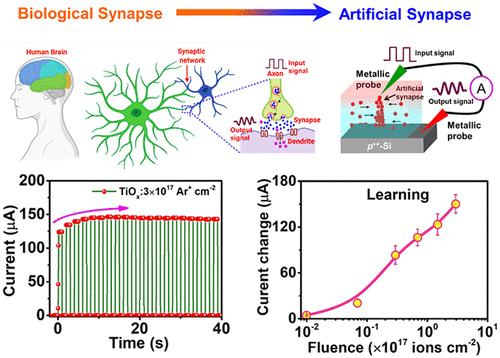当前位置:
X-MOL 学术
›
ACS Appl. Electron. Mater.
›
论文详情
Our official English website, www.x-mol.net, welcomes your
feedback! (Note: you will need to create a separate account there.)
Ion Beam-Mediated Defect Engineering in TiOx Thin Films for Controlled Resistive Switching Property and Application
ACS Applied Electronic Materials ( IF 4.3 ) Pub Date : 2021-08-17 , DOI: 10.1021/acsaelm.1c00417 Dilruba Hasina 1, 2 , Mohit Kumar 3 , Ranveer Singh 1, 2 , Safiul Alam Mollick 4 , Anirban Mitra 5 , Sanjeev Kumar Srivastava 6 , Minh Anh Luong 7 , Tapobrata Som 1, 2
ACS Applied Electronic Materials ( IF 4.3 ) Pub Date : 2021-08-17 , DOI: 10.1021/acsaelm.1c00417 Dilruba Hasina 1, 2 , Mohit Kumar 3 , Ranveer Singh 1, 2 , Safiul Alam Mollick 4 , Anirban Mitra 5 , Sanjeev Kumar Srivastava 6 , Minh Anh Luong 7 , Tapobrata Som 1, 2
Affiliation

|
Defect density and its migration under the influence of an applied electric field plays a crucial role for memristors toward designing a fundamental element of neuromorphic computing, e.g., an artificial synapse. Therefore, to have tunable performance, even at the nanoscale, it is essential to have better control over the defect density, albeit achieving it with direct growth methods remains a challenge. Here, we demonstrate an effective and robust approach to tune the defect density and consequently resistive switching behavior in TiOx layers using low energy argon ion implantation as a tool. Interestingly, by selecting appropriate implantation parameters an adjustable nanoscale resistive switching property, in terms of increased memory window and lower operative voltage, is achieved. These findings are attributed to ion-beam induced controlled defect engineering and are well supported by our experimental results and the predictions of Monte Carlo simulation results. Further, learning ability with an input electric stimuli strongly depends on the implantation fluence, revealing a striking similarity with biological synapses. The present study provides a one-step processing to tune the defect density and in turn resistive switching behavior for designing advanced memory devices and neuromorphic computing.
中文翻译:

用于可控电阻开关特性的 TiOx 薄膜中的离子束介导缺陷工程及应用
缺陷密度及其在外加电场影响下的迁移对于忆阻器设计神经形态计算的基本元素(例如人工突触)起着至关重要的作用。因此,要获得可调谐的性能,即使在纳米级,也必须更好地控制缺陷密度,尽管通过直接生长方法实现它仍然是一个挑战。在这里,我们展示了一种有效且稳健的方法来调整 TiO x 中的缺陷密度和电阻开关行为层使用低能氩离子注入作为工具。有趣的是,通过选择适当的注入参数,实现了可调节的纳米级电阻开关特性,即增加的存储窗口和较低的工作电压。这些发现归因于离子束诱导的受控缺陷工程,并得到了我们的实验结果和蒙特卡罗模拟结果的预测的充分支持。此外,输入电刺激的学习能力强烈依赖于植入通量,揭示了与生物突触的惊人相似之处。本研究提供了一种一步处理来调整缺陷密度,进而调整电阻开关行为,用于设计先进的存储设备和神经形态计算。
更新日期:2021-09-28
中文翻译:

用于可控电阻开关特性的 TiOx 薄膜中的离子束介导缺陷工程及应用
缺陷密度及其在外加电场影响下的迁移对于忆阻器设计神经形态计算的基本元素(例如人工突触)起着至关重要的作用。因此,要获得可调谐的性能,即使在纳米级,也必须更好地控制缺陷密度,尽管通过直接生长方法实现它仍然是一个挑战。在这里,我们展示了一种有效且稳健的方法来调整 TiO x 中的缺陷密度和电阻开关行为层使用低能氩离子注入作为工具。有趣的是,通过选择适当的注入参数,实现了可调节的纳米级电阻开关特性,即增加的存储窗口和较低的工作电压。这些发现归因于离子束诱导的受控缺陷工程,并得到了我们的实验结果和蒙特卡罗模拟结果的预测的充分支持。此外,输入电刺激的学习能力强烈依赖于植入通量,揭示了与生物突触的惊人相似之处。本研究提供了一种一步处理来调整缺陷密度,进而调整电阻开关行为,用于设计先进的存储设备和神经形态计算。











































 京公网安备 11010802027423号
京公网安备 11010802027423号